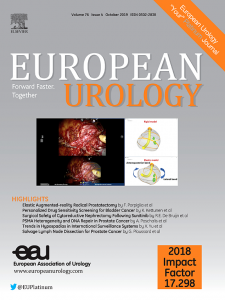Outcomes of Salvage Robotic-assisted Radical Prostatectomy: High-volume Multicentric Data from the European Association of Urology Robotic Urology Section Scientific Working Group
IF 25.3
1区 医学
Q1 UROLOGY & NEPHROLOGY
引用次数: 0
Abstract
Background and objective
Salvage robotic-assisted radical prostatectomy (S-RARP) is one option for treating patients with recurrent prostate cancer after prostate-preserving primary therapy. However, the tissue damage, anatomical distortion, and lack of surgical landmarks caused by the primary treatment still constitute a major challenge to surgeons. We aim to report the experience of our group on S-RARP.
Methods and surgical procedure
A retrospective multicentric study including data from nine centers from the European Association of Urology Robotic Urology Section Scientific Working Group was conducted. Overall, 397 patients who underwent S-RARP from 2008 to 2023 were included and divided into three groups (primary radiation therapy [RT], whole gland [WG] ablation, and focal gland [FG] ablation). The primary endpoints were the safety and feasibility of S-RARP. The secondary endpoints were the comparison of functional and oncological outcomes among different primary therapies.
Key findings and limitations
The median (interquartile range) follow-up periods for RT, FG ablation, and WG ablation were 38 (19–73), 20 (10–37), and 24 (16–38) mo, respectively (p < 0.001). Only four patients (1%) had intraoperative complications and <2% had Clavien grade ≥3 after surgery. The 5-yr cumulative incidence rates of biochemical recurrence were 35%, 45%, and 23% for RT, FG ablation, and WG ablation, respectively (p = 0.3). The 3-yr cumulative incidence rates of continence were 67%, 92%, and 71% for RT, FG ablation, and WG ablation, respectively (p < 0.001). The 5-yr cumulative incidence rates of potency were 16%, 11%, and 5.3% (p = 0.2), while the overall survival rates at 5 yr were 95%, 94%, and 100% for RT, FG ablation, and WG ablation, respectively (p = 0.7).
Conclusions
S-RARP is safe and feasible with very low rates of perioperative complications. Functional outcomes in patients undergoing S-RARP are inferior to outcomes at primary surgery and demand highly skilled surgical expertise. Patients should be counseled carefully that the functional outcomes are inferior to those at primary surgery.
挽救机器人辅助根治性前列腺切除术的结果:来自欧洲泌尿外科协会机器人泌尿外科科学工作组的大容量多中心数据
背景和目的沙维机器人辅助前列腺癌根治术(S-RARP)是治疗前列腺保留初治后复发前列腺癌患者的一种选择。然而,初次治疗造成的组织损伤、解剖变形和手术标志缺失仍是外科医生面临的一大挑战。我们旨在报告我们小组在 S-RARP 方面的经验。方法和手术过程我们进行了一项回顾性多中心研究,包括欧洲泌尿外科协会机器人泌尿外科科学工作组九个中心的数据。总共纳入了2008年至2023年期间接受S-RARP的397名患者,并将其分为三组(原发性放射治疗[RT]、全腺[WG]消融和病灶腺[FG]消融)。主要终点是 S-RARP 的安全性和可行性。主要发现和局限性RT、FG消融和WG消融的中位(四分位间距)随访时间分别为38(19-73)、20(10-37)和24(16-38)个月(p < 0.001)。只有 4 名患者(1%)出现术中并发症,<2% 的患者术后 Clavien 分级≥3。RT、FG消融术和WG消融术的5年累积生化复发率分别为35%、45%和23%(p = 0.3)。RT、FG消融术和WG消融术的3年累积尿失禁发生率分别为67%、92%和71%(P = 0.001)。RT、FG消融术和WG消融术的5年累计失禁率分别为16%、11%和5.3%(P = 0.2),5年总生存率分别为95%、94%和100%(P = 0.7)。接受 S-RARP 手术的患者的功能预后不如初治手术,需要高度熟练的外科专业知识。应仔细告知患者,其功能效果不如初次手术。
本文章由计算机程序翻译,如有差异,请以英文原文为准。
求助全文
约1分钟内获得全文
求助全文
来源期刊

European urology
医学-泌尿学与肾脏学
CiteScore
43.00
自引率
2.60%
发文量
1753
审稿时长
23 days
期刊介绍:
European Urology is a peer-reviewed journal that publishes original articles and reviews on a broad spectrum of urological issues. Covering topics such as oncology, impotence, infertility, pediatrics, lithiasis and endourology, the journal also highlights recent advances in techniques, instrumentation, surgery, and pediatric urology. This comprehensive approach provides readers with an in-depth guide to international developments in urology.
 求助内容:
求助内容: 应助结果提醒方式:
应助结果提醒方式:


